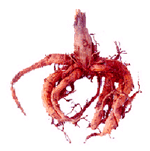
Coleus Forskohlii
Introduction
This fact sheet provides basic information about Coleus Forskohli. Coleus forskohli is a perennial member of the mint, or Lamiaceae, family that was first discovered in the lower elevations of India. It is now grown around the world as an ornamental plant. The root is used for a myriad of medicinal purposes. As recorded in ancient Sanskrit texts, coleus has been used as a medical herb to treat heart and lung diseases, intestinal spasms, insomnia, and convulsions.
Common Names
Pashanabhedi, Makandi, Colforsin, HL-362
Latin Names
Coleus forskohlii
What It Is Used For
- Forskolin has been shown to dilate the blood vessels causing a decrease in blood pressure, increase the contractility of the heart, inhibit platelet aggregation, and relax contracted airways in asthma patients. Because of its multiple sites of action, it should be used with caution.
How It Is Used
Forskolin is a chemical found in the coleus herb that activates the enzyme adenylate cyclase. Andenylate cyclase compound initiates a myriad of critical events and processes within all the cells of the human body. Adenylate cyclase and the chemicals it activates are responsible for executing a number of important hormonal processes. Stimulation that is caused by forskolin supposedly leads to blood vessel dilation, inhibition of allergic reactions, and possibly an increased secretion of thyroid hormone. Forskolin has other reported uses as well, including inhibition of the pro-inflammatory substance known as platelet-activating factor (PAF) 6 and inhibition of the spread of cancer cells.
What the Science Says
- Research reveals little or no information regarding toxicology with the use of this product.
- The smooth muscle relaxant properties of forskolin also have led to investigation of its use in asthma.
- In human heart tissues, forskolin activated adenylate cyclase and showed strong positive inotropic properties that were synergistic with isoproterenol.
Side Effects and Cautions
- Avoid use with anticoagulants, antihypertensives, and vasodilators because of additive effects.
- Avoid use with ulcers because of stimulation of gastric acid and in diabetes due to stimulation of lipid release and gluconeogenesis.
Sources







